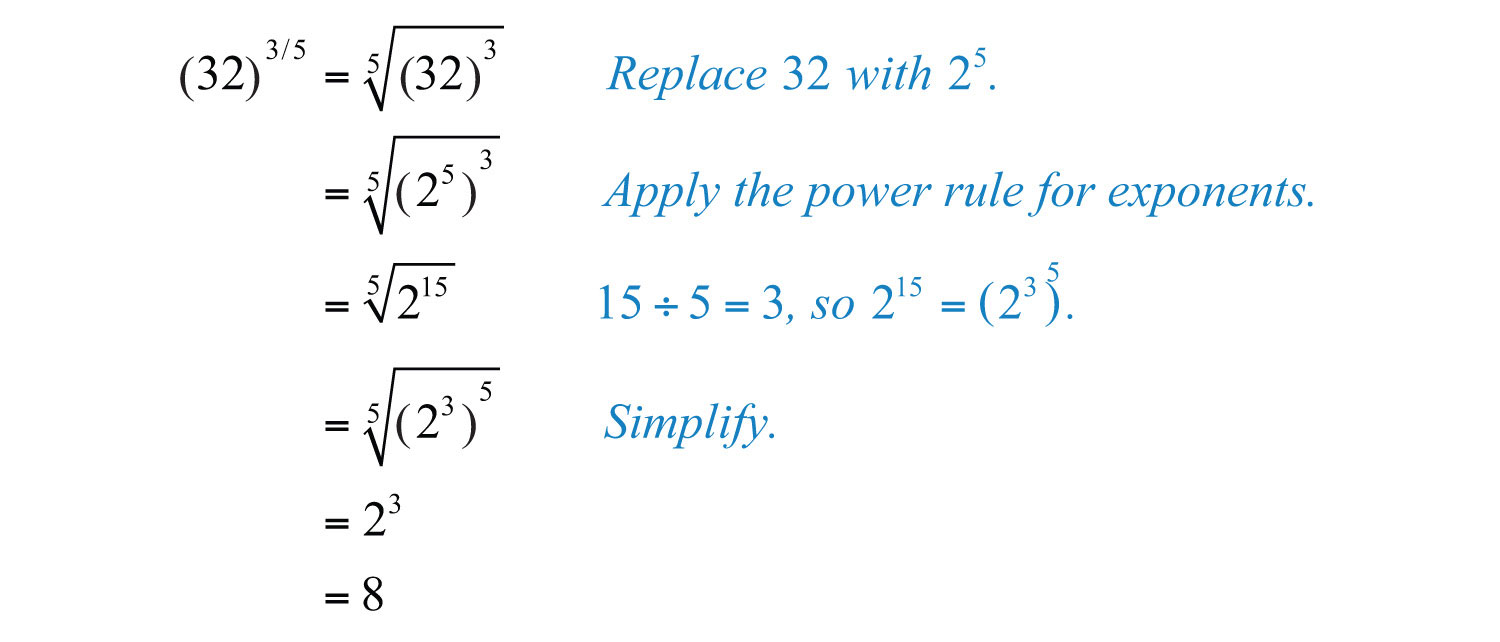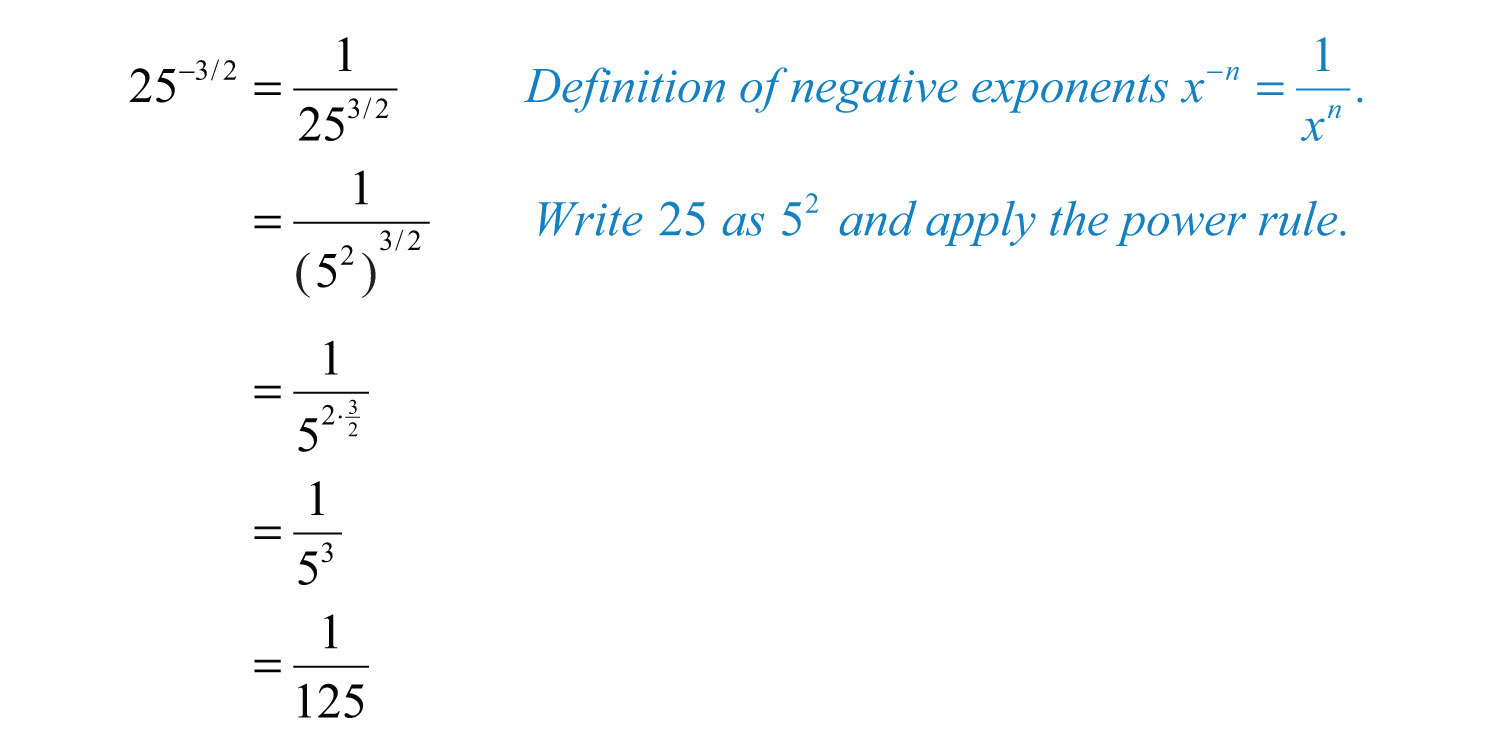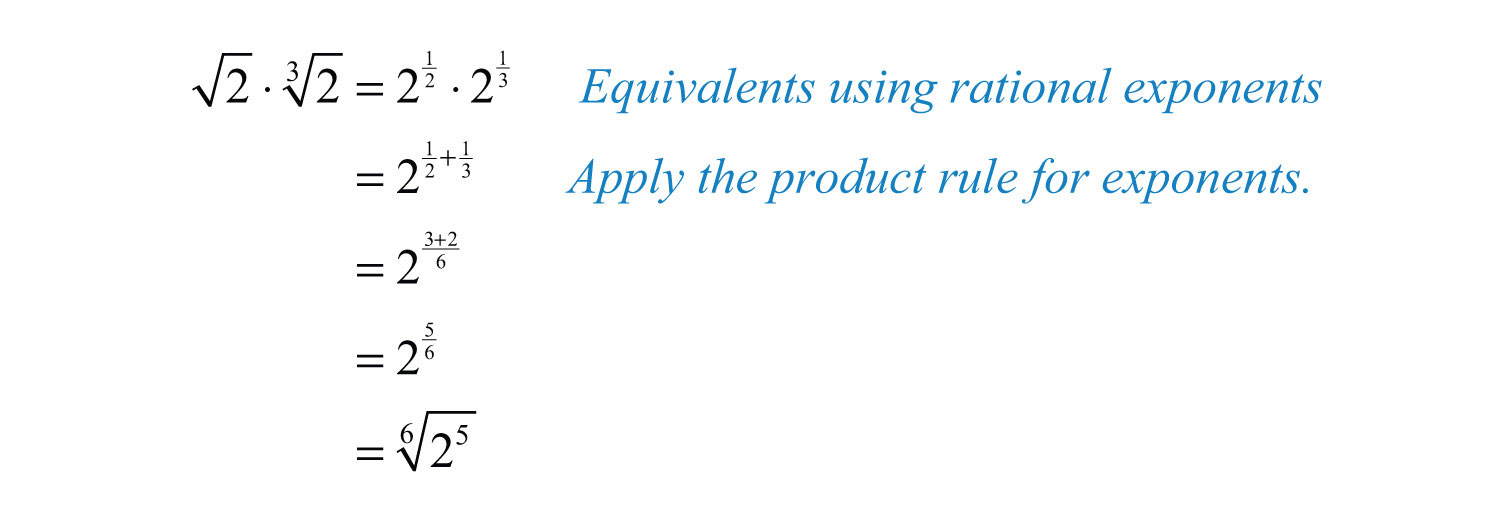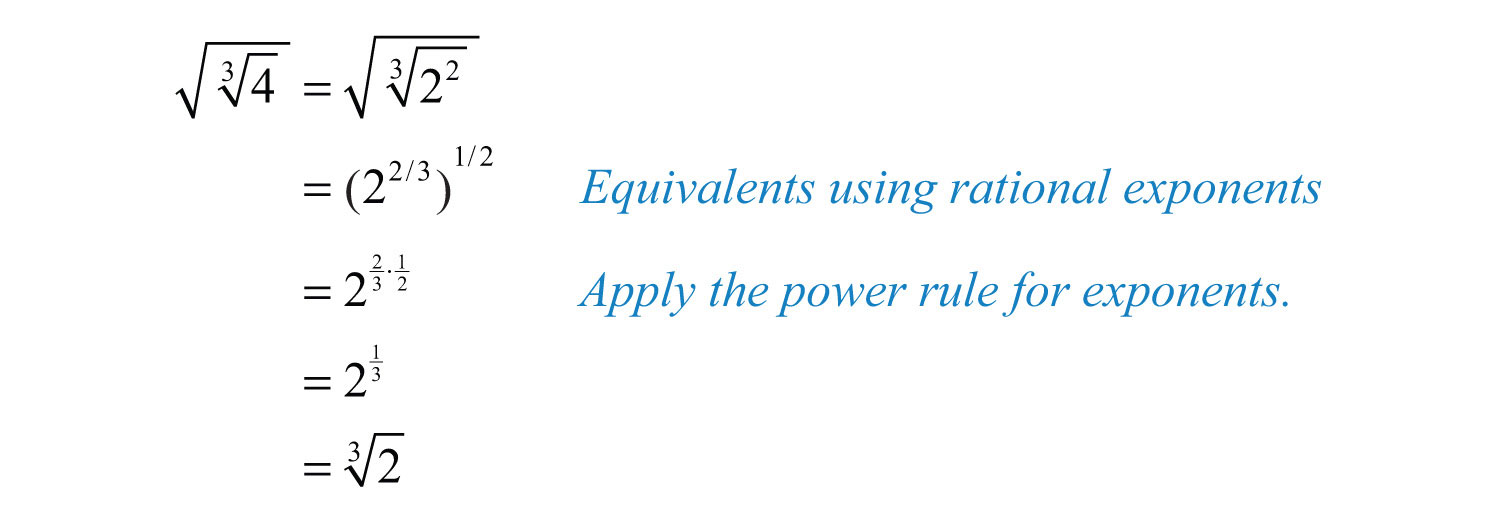This is “Rational Exponents”, section 8.5 from the book Beginning Algebra (v. 1.0). For details on it (including licensing), click here.
For more information on the source of this book, or why it is available for free, please see the project's home page. You can browse or download additional books there. To download a .zip file containing this book to use offline, simply click here.
8.5 Rational Exponents
Learning Objectives
- Write expressions with rational exponents in radical form.
- Write radical expressions with rational exponents.
- Perform operations and simplify expressions with rational exponents.
- Perform operations on radicals with different indices.
Definition of Rational Exponents
So far, exponents have been limited to integers. In this section, we will define what rational (or fractional) exponentsThe fractional exponent m/n that indicates a radical with index n and exponent m: . mean and how to work with them. All of the rules for exponents developed up to this point apply. In particular, recall the product rule for exponents. Given any rational numbers m and n, then

For example, if we have an exponent of , then the product rule for exponents implies the following:

Here is one of two equal factors of 5; hence it is a square root of 5, and we can write

Furthermore, we can see that is one of three equal factors of 2.

Therefore, is the cube root of 2, and we can write

This is true in general, given any nonzero real number a,

In other words, the denominator of a fractional exponent determines the index of an nth root.
Example 1: Rewrite as a radical.
a.
b.
Solution:
a.
b.
Example 2: Rewrite as a radical and then simplify.
a.
b.
Solution:
a.
b.
Example 3: Rewrite as a radical and then simplify.
a.
b.
Solution:
a.

b.

Next, consider fractional exponents where the numerator is an integer other than 1. For example, consider the following:

This shows that is one of three equal factors of . In other words, is the cube root of and we can write:

In general, given any real number a,

An expression with a rational exponent is equivalent to a radical where the denominator is the index and the numerator is the exponent. Any radical expression can be written with a rational exponent, which we call exponential formAn equivalent expression written using a rational exponent..

Example 4: Rewrite as a radical.
a.
b.
Solution:
a.
b.
Example 5: Rewrite as a radical and then simplify.
a.
b.
Solution:
a.

b. We can often avoid very large integers by working with their prime factorization.

Given a radical expression, we will be asked to find the equivalent in exponential form. Assume all variables are positive.
Example 6: Rewrite using rational exponents: .
Solution: Here the index is 3 and the power is 2. We can write

Answer:
Example 7: Rewrite using rational exponents: .
Solution: Here the index is 6 and the power is 3. We can write

Answer:
It is important to note that the following are equivalent.

In other words, it does not matter if we apply the power first or the root first. For example, we can apply the power before the root:

Or we can apply the nth root before the power:

The results are the same.
Example 8: Rewrite as a radical and then simplify: .
Solution: Here the index is 3 and the power is 2. We can write

Answer: 4
Try this! Rewrite as a radical and then simplify: .
Answer: 125
Video Solution
(click to see video)Some calculators have a caret button . If so, we can calculate approximations for radicals using it and rational exponents. For example, to calculate , we would type

To calculate , we would type

Operations Using the Rules of Exponents
In this section, we review all of the rules of exponents, which extend to include rational exponents. If given any rational numbers m and n, then we have
| Product rule: | |
| Quotient rule: | |
| Power rule: | |
| Power rule for a product: | |
| Power rule for a quotient: | |
| Negative exponents: | |
| Zero exponent: |
These rules allow us to perform operations with rational exponents.
Example 9: Simplify: .
Solution:

Answer:
Example 10: Simplify: .
Solution:

Answer:
Example 11: Simplify: .
Solution:

Answer:
Example 12: Simplify: .
Solution:

Answer:
Example 13: Simplify: .
Solution:

Answer: 1/125
Try this! Simplify: .
Answer:
Video Solution
(click to see video)Radical Expressions with Different Indices
To apply the product or quotient rule for radicals, the indices of the radicals involved must be the same. If the indices are different, then first rewrite the radicals in exponential form and then apply the rules for exponents.
Example 14: Multiply: .
Solution: In this example, the index of each radical factor is different. Hence the product rule for radicals does not apply. Begin by converting the radicals into an equivalent form using rational exponents. Then apply the product rule for exponents.

Answer:
Example 15: Divide: .
Solution: In this example, the index of the radical in the numerator is different from the index of the radical in the denominator. Hence the quotient rule for radicals does not apply. Begin by converting the radicals into an equivalent form using rational exponents and then apply the quotient rule for exponents.

Answer:
Example 16: Simplify: .
Solution: Here the radicand of the square root is a cube root. After rewriting this expression using rational exponents, we will see that the power rule for exponents applies.

Answer:
Key Takeaways
- When converting fractional exponents to radicals, use the numerator as the power and the denominator as the index of the radical.
- All the rules of exponents apply to expressions with rational exponents.
Topic Exercises
Part A: Rational Exponents
Express using rational exponents.
1.
2.
3.
4.
5.
6.
7.
8.
9.
10.
Express in radical form.
11.
12.
13.
14.
15.
16.
17.
18.
19.
20.
Write as a radical and then simplify.
21.
22.
23.
24.
25.
26.
27.
28.
29.
30.
31.
32.
33.
34.
35.
36.
37.
38.
39.
40.
41.
42.
43.
44.
45.
46.
47.
48.
49.
50.
51.
52.
53.
54.
55.
56.
Use a calculator to approximate an answer rounded to the nearest hundredth.
57.
58.
59.
60.
61.
62.
63. Explain why (−4)^(3/2) gives an error on a calculator and −4^(3/2) gives an answer of −8.
64. Marcy received a text message from Mark asking her how old she was. In response, Marcy texted back “125^(2/3) years old.” Help Mark determine how old Marcy is.
Part B: Rational Exponents
Perform the operations and simplify. Leave answers in exponential form.
65.
66.
67.
68.
69.
70.
71.
72.
73.
74.
75.
76.
77.
78.
79.
80.
81.
82.
83.
84.
85.
86.
87.
88.
89.
90.
91.
92.
93.
94.
95.
96.
Part C: Mixed Indices
Perform the operations.
97.
98.
99.
100.
101.
102.
103.
104.
105.
106.
107.
108.
109.
110.
111.
112.
113.
114.
Part D: Discussion Board
115. Who is credited for devising the notation for rational exponents? What are some of his other accomplishments?
116. When using text, it is best to communicate nth roots using rational exponents. Give an example.
Answers
1:
3:
5:
7:
9:
11:
13:
15:
17:
19:
21: 5
23: 11
25: 1/2
27: 1/2
29: 2
31: 2
33: 1/3
35: −3
37: 2
39: 1/3
41: 10
43: 1/2
45: 27
47: 32
49: 64
51: 1/8
53: 9
55: −8
57: 1.68
59: 1.38
61: Not a real number
63: In the first expression, the square root of a negative number creates an error condition on the calculator. The square root of a negative number is not real. In the second expression, because of the order of operations, the negative sign is applied to the answer after 4 is raised to the (3/2) power.
65: 4
67:
69:
71: 25
73:
75: 2
77:
79:
81:
83:
85:
87:
89:
91:
93:
95:
97:
99:
101:
103:
105:
107:
109:
111:
113:




